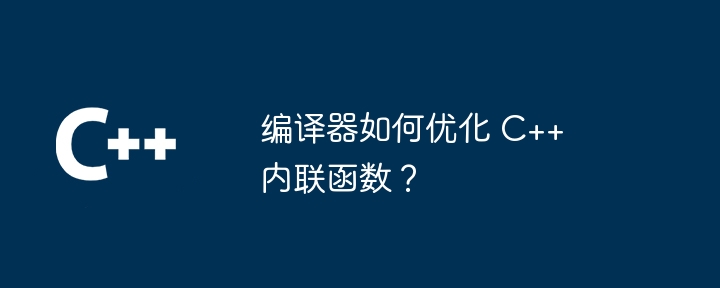Home >Backend Development >C++ >How does the compiler optimize C++ inline functions?
How does the compiler optimize C++ inline functions?
- WBOYWBOYWBOYWBOYWBOYWBOYWBOYWBOYWBOYWBOYWBOYWBOYWBOriginal
- 2024-04-17 09:57:01644browse
The compiler's main methods for optimizing inline functions are: heuristic-based: using rules to evaluate the possibility of function inlining. Threshold-based: Do not inline if it exceeds a set threshold (such as function size or number of calls). Profile-based: Use runtime data to dynamically determine inline functions.

How the compiler optimizes C inline functions
Preface
Inline Functions are a C compiler optimization technique that replaces function calls directly with function bodies. This can significantly improve performance, especially in the case of frequently called functions.
Compiler optimization methods
Typical methods for compilers to optimize inline functions include:
- Based on heuristics: The compiler uses a set of heuristic rules to determine whether to inline a function. These rules may take into account function size, frequency of calls, and other factors of the calling context.
- Threshold-based: The compiler sets a threshold, and if the function size or number of calls exceeds the threshold, the component will not be inlined.
- Profile-based: The compiler uses data collected at runtime to dynamically decide which functions to inline. This allows the compiler to optimize for specific code paths, improving overall performance.
Enabling inlining in the compiler
In most C compilers, inlining can be enabled via compile flags or compiler options. For example, in GCC, use the -finline-functions flag.
Practical case
Consider the following example function:
int multiply(int a, int b) {
return a * b;
}If the function is called frequently, the compiler may inline it as:
int main() {
int result = a * b;
// ...
}This eliminates the overhead of function calls and improves performance.
Limitations
While inlining is often beneficial, it is not appropriate in all situations. For example:
- Recursive functions are generally not suitable for inlining because this may cause stack overflow.
- Large function inlining may increase executable file size.
- Inlining may affect the program's debugging information.
Conclusion
Inlining functions is an effective technique for C compiler optimization that can significantly improve performance by directly replacing function calls. The compiler uses various methods to determine which functions are suitable for inlining, and inlining can be enabled in the compiler through compile flags or options. Understanding the benefits and limitations of inlining is critical to optimizing C code.
The above is the detailed content of How does the compiler optimize C++ inline functions?. For more information, please follow other related articles on the PHP Chinese website!

